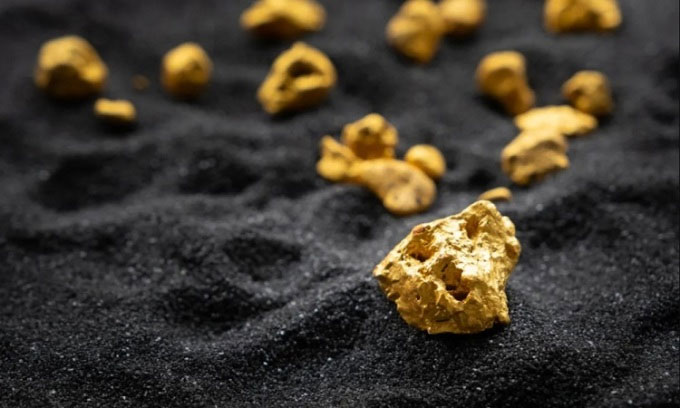Where 99% of the gold on Earth is concentrated
Most of the gold on Earth is concentrated in the Earth's core, beyond human ability to mine .
Experts estimate that there is so much gold on Earth that every inch of the earth could be covered to a depth of 50 centimeters. But gold remains a rare metal because most of it sinks to the Earth's core and is out of reach for any miners, according to IFL Science .

The amount of gold humans mine is only a fraction of the amount of gold in the Earth's core. (Photo: Phawatt)
The Earth's core is made up mostly of iron and nickel. Researchers have discovered this by looking at the way seismic waves from earthquakes travel through the core. However, the presence of impurities that change the wave's density is too difficult to detect specifically, unless their radiation contributes to high temperatures, as uranium and thorium do.
The existence of these precious metal inclusions remains a mystery . However, in 2006, a team of scientists found a way to estimate their abundance. According to them, some asteroids have a similar composition to Earth because they formed in the same region of the protoplanetary disk. By measuring the composition of carbonaceous chondrite meteorites from these asteroids, they were able to calculate the amount of each element on Earth. Subtracting the known concentrations in the crust and mantle, the team was able to deduce the amount of that element in the Earth's core.
Professor Bernard Wood, a geologist at Macquarie University, and colleagues looked at the early history of Earth, starting with the formation of the Solar System more than 4.5 billion years ago and focusing on the birth of the Earth's molten metal core. They suggest that Earth was probably covered by an ocean of molten rock hundreds of kilometres deep during this period. This magma ocean reacted with metals throughout the planet's development, extracting many important elements, including gold, and depositing them in the Earth's iron-rich core.
After comparing the Earth's crust with meteorites, the team found that Earth is very similar to meteorites chemically, but its crust has lost most of the elements that go into iron, such as gold, platinum, and nickel. The only place for them to accumulate is in the molten core.
Based on this, Wood and his colleagues were able to calculate the amount of each element mixed with liquid iron and found that more than 99% of Earth's gold is in the core. Likewise, surviving asteroids, especially those that represent planetesimal cores, still contain large amounts of elements. Accessing them is difficult, but still much easier than drilling to the core. That's why NASA plans to launch a probe to the asteroid Psyche in two months.
Articles about the Psyche mission often estimate the value of the asteroid at $10 trillion, but if there were such a large source of rare metals available, its value would plummet. The same is true of the price of gold. If humans could bring all the gold from the core to the surface, no one would pay for it.
- The origin of gold on Earth
- Gold is formed like?
- Discover new gold form in the center of Earth
- Interesting little things about gold
- How did the gold mines on Earth form?
- Gold on Earth may come from dead stars
- The interesting thing about gold may be unknown to you
- Why do we like gold?
- Use Google Earth to find the gold mine
- Gold does not naturally arise and does not lose itself, but ... falls from the sky
- Difficult questions: How much gold is in the sea?
- Instructions on how to buy gold, distinguish real gold and fake gold
 'Fine laughs' - Scary and painful torture in ancient times
'Fine laughs' - Scary and painful torture in ancient times The sequence of numbers 142857 of the Egyptian pyramids is known as the strangest number in the world - Why?
The sequence of numbers 142857 of the Egyptian pyramids is known as the strangest number in the world - Why? History of the iron
History of the iron What is alum?
What is alum? Amazing discovery of 4.5 billion year old alien ocean of life
Amazing discovery of 4.5 billion year old alien ocean of life  What would happen if you dug a hole through the Earth and jumped in?
What would happen if you dug a hole through the Earth and jumped in?  Chilling discovery of cosmic object that almost brought the Earth to 'apocalypse'
Chilling discovery of cosmic object that almost brought the Earth to 'apocalypse'  The Sun goes into hibernation, will the Earth usher in a new ice age?
The Sun goes into hibernation, will the Earth usher in a new ice age?  Discovery of space object powerful enough to tear apart the Earth
Discovery of space object powerful enough to tear apart the Earth  NASA to test 'pneumatic brakes' for Mars lander
NASA to test 'pneumatic brakes' for Mars lander 